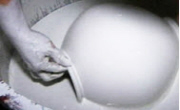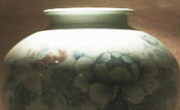오늘날 디지털 기술은 거의 모든 인간 활동에 침투해 있기 때문에 공예작업에도 커다란 영향을 미치고 있다. 특히 CAD/CAM, CNC, RP와 같이 디지털 방식으로 제어되는 제조기술들이 그러한 영향...
http://chineseinput.net/에서 pinyin(병음)방식으로 중국어를 변환할 수 있습니다.
변환된 중국어를 복사하여 사용하시면 됩니다.
- 中文 을 입력하시려면 zhongwen을 입력하시고 space를누르시면됩니다.
- 北京 을 입력하시려면 beijing을 입력하시고 space를 누르시면 됩니다.

CNC(Computerized Numerical Control)프로세스를 이용한 도자작업의 조형적 특성연구 = A study on the morphological characteristics of ceramic arts using CNC process
한글로보기부가정보
국문 초록 (Abstract)
기술적 가능성 : ①정밀함에 의한 형태의 정확성 ②정밀가공에 의한 결합 가능성 ③신속함에 의한 형태의 다양성 ④제작과정의 유연성 ⑤일괄처리에 의한 작업의 동시성 ⑥수치화된 형상의 조합에 의한 변화 가능성조형적 특성 : ① 평균에 의한 연속성과 균일함 ② 균일한 가공에 의한 정적(靜的) 형태 ③ CAD의 인터페이스에 따른 형태 편향성 ④ CNC의 가공축에 의한 형태 편향성 ⑤ 연속되는 선 ⑥ 반복성
오늘날 디지털 기술은 거의 모든 인간 활동에 침투해 있기 때문에 공예작업에도 커다란 영향을 미치고 있다. 특히 CAD/CAM, CNC, RP와 같이 디지털 방식으로 제어되는 제조기술들이 그러한 영향의 중심에 있다. 이러한 기술들은 소규모 유연생산에 적합하기 때문에 제품도자 생산의 측면에서 많은 잠재력을 가지고 있으며, 그에 못지않게 공예작업 도구로서의 가능성도 매우 크다. 우리의 환경이 디지털화되는 추세는 돌이킬 수도 막을 수도 없지만, 우리가 살고 있는 곳은 여전히 물질로 구성된 연속성의 세계이며 비트(bit)로 대체할 수 없는 영역에 속해있다. 도자작업과 도자기는 그 영역에 포함되어 있는 것이다. 따라서 중요한 것은 도자를 디지털화하는 것이 아니라 디지털 기술이 도자제작에 제공할 수 있는 이점이 무엇인가를 이해하고, 디지털 기술이 창출하는 조형적 특성을 정확하게 파악하여 작업에 적용하는데 있다. 이 논문에서는 지난 15년간 디지털 기기를 사용한 도예가들의 작업과 연구를 토대로 이러한 디지털 장비들이 도자제작에 줄 수 있는 기술적 가능성과 조형적 특성을 알아보았으며, 그 결과 다음과 같은 결론에 도달하였다.
기술적 가능성 : ①정밀함에 의한 형태의 정확성 ②정밀가공에 의한 결합 가능성 ③신속함에 의한 형태의 다양성 ④제작과정의 유연성 ⑤일괄처리에 의한 작업의 동시성 ⑥수치화된 형상의 조합에 의한 변화 가능성조형적 특성 : ① 평균에 의한 연속성과 균일함 ② 균일한 가공에 의한 정적(靜的) 형태 ③ CAD의 인터페이스에 따른 형태 편향성 ④ CNC의 가공축에 의한 형태 편향성 ⑤ 연속되는 선 ⑥ 반복성
다국어 초록 (Multilingual Abstract)
Technical possibilities : ①accuracy by precision, ②combining possibility by precise process ③variety by swiftness, ④flexibility of manufacturing process, ⑤simultaneity of work by batch processing ⑥variation by combination of digitized shapes.
Morphological characters : ① continuity by the average, ② static shape by the uniform control, ③ morphological bias by the CAD interface, ④ morphological bias by the CNC axis system, ⑤ continuous line, ⑥ repeatability
Today, digital technology is infiltrated into all activities of human beings and has great influence on craft works as well. In particular, manufacturing techniques controlled by digital forms such as CAD/CAM, CNC, and RP are in the center of the infl...
Today, digital technology is infiltrated into all activities of human beings and has great influence on craft works as well. In particular, manufacturing techniques controlled by digital forms such as CAD/CAM, CNC, and RP are in the center of the influence. These technologies are suitable for flexible manufacturing and has significant potential in the aspect of industrial production of ceramics, as well as a possibility to use in the craft field. The trend of digitalization of our environment is irreversible and can not be stopped, but the place we are living in is still the world of continuity consisted of material which belongs to the domain that can not be replaced by bits. Ceramic works and potteries are included in this domain. As a result, what is important is not to digitalize the ceramics but to understand the advantage of digital technology in the production of ceramic and to apply it in the work through precise appreciation of the aesthetic characteristics created by the digital technology. In this paper, technical possibilities and morphological characters acquired by using digital equipments in the production of ceramic arts were reviewed based on the works of ceramists who used digital equipment for the past 15 years. The results are proposed as follows.
Technical possibilities : ①accuracy by precision, ②combining possibility by precise process ③variety by swiftness, ④flexibility of manufacturing process, ⑤simultaneity of work by batch processing ⑥variation by combination of digitized shapes.
Morphological characters : ① continuity by the average, ② static shape by the uniform control, ③ morphological bias by the CAD interface, ④ morphological bias by the CNC axis system, ⑤ continuous line, ⑥ repeatability
참고문헌 (Reference)
1 최병건, "디지털 기기를 이용한 도자디자인과 제작" 2003
2 "www.oktavius.co.uk"
3 "www.justinmarshall.co.uk"
4 "www.brianadams.co.uk"
5 "www.autonomatic.org.uk"
6 Sasha Wardell, "Slipcasting" A & C Black 1997
7 Sasha Wardell, "Porcelain and Bone China" The Crowood Press 2004
8 Justin Marshall, "Computers and creativity" (194) : 1993
9 황승욱, "CNC 절삭가공(machining)에서 cusp의 형태 변용 연구" 한국기초조형학회 7 (7): 675-687, 2006
10 최병건, "CACD(Computer Aided Ceramic Design)를 이용한 인체 표현 연구 ━ 도자제품 및 오브제를 중심으로 ━" 한국도자학회 2 (2): 89-102, 2005
1 최병건, "디지털 기기를 이용한 도자디자인과 제작" 2003
2 "www.oktavius.co.uk"
3 "www.justinmarshall.co.uk"
4 "www.brianadams.co.uk"
5 "www.autonomatic.org.uk"
6 Sasha Wardell, "Slipcasting" A & C Black 1997
7 Sasha Wardell, "Porcelain and Bone China" The Crowood Press 2004
8 Justin Marshall, "Computers and creativity" (194) : 1993
9 황승욱, "CNC 절삭가공(machining)에서 cusp의 형태 변용 연구" 한국기초조형학회 7 (7): 675-687, 2006
10 최병건, "CACD(Computer Aided Ceramic Design)를 이용한 인체 표현 연구 ━ 도자제품 및 오브제를 중심으로 ━" 한국도자학회 2 (2): 89-102, 2005
11 Taus Jørgensen, "Binary Tools"
12 Justin Marshall, "AutoMAKE: Generative systems, digital manufacture and craft production" 2007
동일학술지(권/호) 다른 논문
-
기초디자인 교육으로서의 건축설계교육의 내용과 구성의 실험적 방법에 관한 연구
- 한국기초조형학회
- 최동혁
- 2010
- KCI등재
-
오지 클라크(Ossie Clark) 패션의 디자인 특성 연구
- 한국기초조형학회
- 김수현
- 2010
- KCI등재
-
농산물 공동브랜드 경쟁력 강화를 위한 브랜드디자인요소에 관한 연구
- 한국기초조형학회
- 소순영
- 2010
- KCI등재
-
- 한국기초조형학회
- 김동섭
- 2010
- KCI등재
분석정보
인용정보 인용지수 설명보기
학술지 이력
| 연월일 | 이력구분 | 이력상세 | 등재구분 |
|---|---|---|---|
| 2027 | 평가예정 | 재인증평가 신청대상 (재인증) | |
| 2021-01-01 | 평가 | 등재학술지 유지 (재인증) |  |
| 2018-01-01 | 평가 | 등재학술지 유지 (등재유지) |  |
| 2015-02-09 | 학술지명변경 | 외국어명 : Bulletin of Korean Society of Basic Design & Art -> Journal of Basic Design & Art |  |
| 2015-01-01 | 평가 | 등재학술지 유지 (등재유지) |  |
| 2011-01-01 | 평가 | 등재학술지 유지 (등재유지) |  |
| 2009-01-01 | 평가 | 등재학술지 유지 (등재유지) |  |
| 2006-01-01 | 평가 | 등재학술지 선정 (등재후보2차) |  |
| 2005-01-01 | 평가 | 등재후보 1차 PASS (등재후보1차) |  |
| 2003-01-01 | 평가 | 등재후보학술지 선정 (신규평가) |  |
학술지 인용정보
| 기준연도 | WOS-KCI 통합IF(2년) | KCIF(2년) | KCIF(3년) |
|---|---|---|---|
| 2016 | 0.33 | 0.33 | 0.34 |
| KCIF(4년) | KCIF(5년) | 중심성지수(3년) | 즉시성지수 |
| 0.34 | 0.34 | 0.512 | 0.08 |




 KCI
KCI DBpia
DBpia





